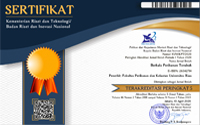MACROBENTHOS DIVERSITY ON KELAPA DUA ISLAND, SERIBU ISLAND NATIONAL PARK, DKI JAKARTA
Abstract
Keywords
Full Text:
PDFReferences
Akhrianti, I. 2014. Distribusi Spasial dan Preferensi Habitat Bivalvia di Pesisir Kecamatan Simpang Pesak Kabupaten Belitung Timur [Tesis].
Allen, G. 1999. Marine Fishes of South-East Asia; A guide for englers and divers. Priplus Editions. Singapore.
Andriana. 2008. Keterkaitan Struktur Komunitas Makrozoobenthos Sebagai Indikator Keberadaan Bahan Organik Di Perairan Hulu Sungai Cisadane Bogor, Jawa Barat" (Skripsi. IPB). Bogor
Arfiati, D., Herawati, E.Y., Buwono, N.R., & Firdaus, A. 2019. Struktur Komunitas Makrozoobentos pada Ekosistem lamun di Paciran, Kabupaten Lamongan, Jawa Timur. Journal of Fisheries and Marine Research, 3(1):Aswari.P. 2001.Keanekaragaman Serangga Air di Tanah Nasional Gunung Halimun.Biologi: LIPI.
Baku Mutu Kep.MenLH No.51 tahun 2004. Baku Mutu Air Laut Untuk Biota Laut.
Brower, J.E. dan J.H. Zar. 1977. Field and Laboratory Method of General Ecology. Wm.C Brown Pulb. Dubuque. Iowa.
Fachrul. M. F. 2007. Metode samplingBioekologi. Jakarta: Bumi Aksara. Jakarta.
Irmawan, R.N., Zulkifli, H.&. Hendri, M. 2010. Struktur Komunitas Makrozoobentos di Estuari Kuala Sugihan, Provinsi Sumatera Selatan. Maspari Journal, 53-58
Ira. 2011. Keterkaitan Padang Lamun Sebagai Pemerangkap dan Penghasil Bahan Organik dengan Struktur Komunitas Makrozoobentos di Perairan Pulau Barrang Lompo [skripsi]. Bogor : Program Studi Ilmu Kelautan Program Pascasarjana. Institut Pertanian Bogor. 97 hlm
Karuniasari, A. 2013. Struktur Komunitas Makrozoobentos sebagai Bioindikator Kualitas Perairan Pulau Panggang Kepulauan Seribu DKI Jkarta. FPIK, Universitas Padjadjaran, Jatinangor.
Marmita, R., R. Siahaan., R. Koneri. Dan M. L. Langoy. 2013. Mak¬rozoobentos Sebagai Indicator Biologis Dalam Menentukan Kualitas Air Sungai Ranoyapo, Minahasa Selatan, Sulawesi Utara. J. Ilmiah Sains 13(1):58-61.
Marpaung, A. A. F. 2013. Keanekaragaman Makrozoobenthos di Ekosistem Mangrove Silvofishery dan Mangrove Alami Kawasan Ekowisata Pantai Boe Kecamatan Galesong Kabupaten Takalar. [Skripsi]. Universitas Hasanuddin Makassar. hlm 16-62.
Minggawati, I. 2013. Struktur Komunitas Makrozoobentos di Perairan Rawa Banjiran Sungai Rungan, Kota Palangka Raya. Ilmu Hewani Tropika, 2(2):64-67.
Nybakken. J. W. 1992. Biologi Laut Suatu Pendekatan Ekologis. Jakarta: Gramedia.
Nybakken, J.W. (1988). Bilogi Laut Suatu Pendekatan Ekologis. Terjemahan M. Ediman, Koesoebiono, D.G Bengen, M. Hutomo, & S. Sukardjo. Jakarta: PT. Gramedia.
Odum.EP. 1993. Dasar-Dsar Ekologi. Edisi Ketiga. Yogyakarta : Gaja Mada University Press.
Roy, S. & Gupta, A. (2010). Molluscan diversity in River Barak and its Tributaries, Assam, India. Assam University Journal of Science and Technology: Biological and Environmental Sciences. 5(1): 109-113.
Saripantung, G. L., J. F. W. S. Tamanampo dan G. Manu. 2013. Struktur Komunitas Gastropoda Dihamparan Lamun Daerah Intertidal Kelurahan Tongkenia Kota Manado. Jurnal Ilmiah Platax. ISSN: 2302-3589. 1 (3) : 103.
Sastrawijaya, A.T. 1991. Pencemaran Lingkungan. Rineka Cipta, Jakarta. 87p.
Setyobudiandi, I., Sulistiono., F. Yulianda., C.Kusmana,C.,S.Hariyadi.,A.Damar., A.Sembiring dan Bahtiar. 2009. Sampling dan Analisis Data Perikanan dan Kelautan; Terapan Metode Pengambilan Contoh di Wilayah Pesisir dan Laut.Bogor: Fakultas Perikanan dan Ilmu Kelautan IPB.Suin, N. M.2003. Ekologi Hewan Tanah. Bumi Aksara. Jakarta
Vyas V, Bharose S, Yousuf S, Kumar A. 2012. Distribution of makrozoobenthos in River Narmada near water intake point. Nat Sci Res 2 (3): 18-25.
Wishnu, NP, Hartati R, Suprijanto J, Soenardjo N & Santosa GW. 2020. Komunitas Makrozoobentos pada Substrat Dasar Lunak di Muara Sungai Wulan, Demak. Buletin Oseanografi Marina April 2020 Vol 9 No 1:19–26
DOI: http://dx.doi.org/10.31258/terubuk.50.2.1551-1558
Refbacks
- There are currently no refbacks.
Copyright (c) 2022 Katarina Hesty Rombe, Agus Surachmat, Etti Sartika Rahayu

This work is licensed under a Creative Commons Attribution 4.0 International License.












